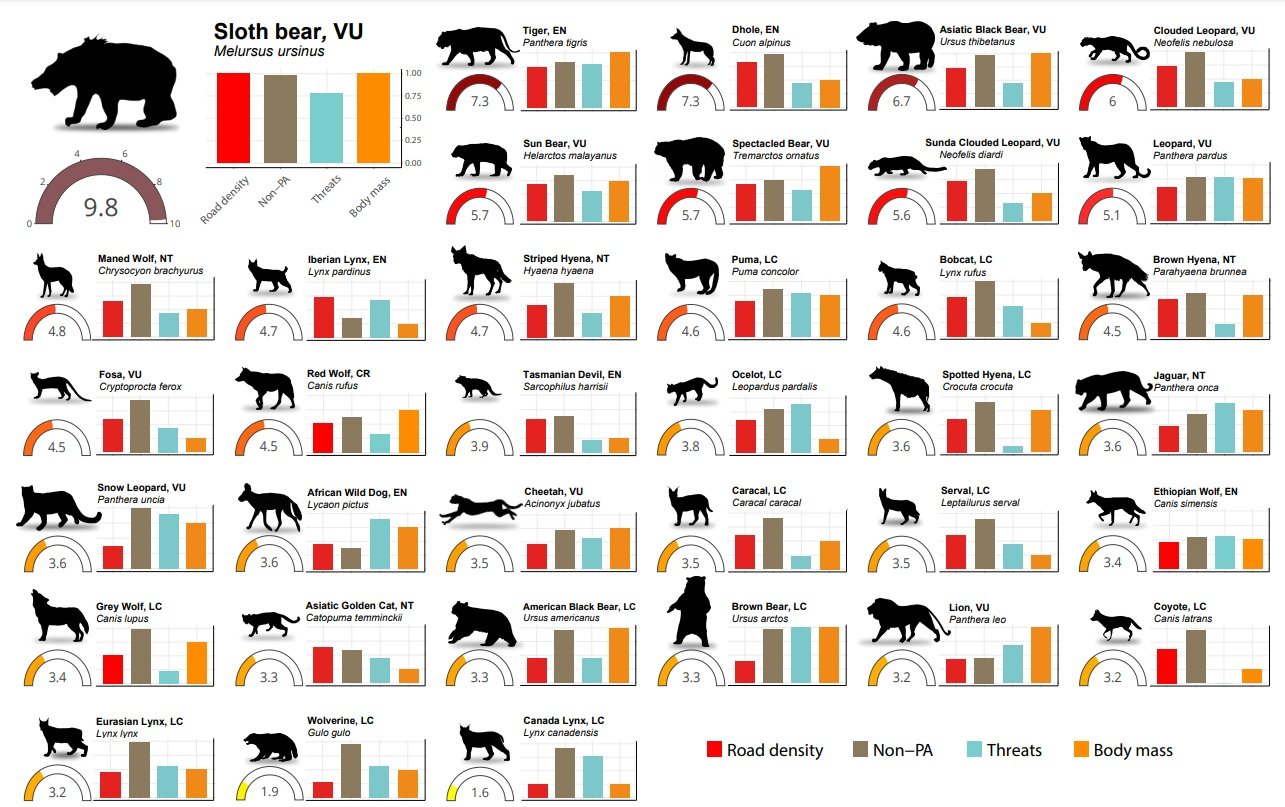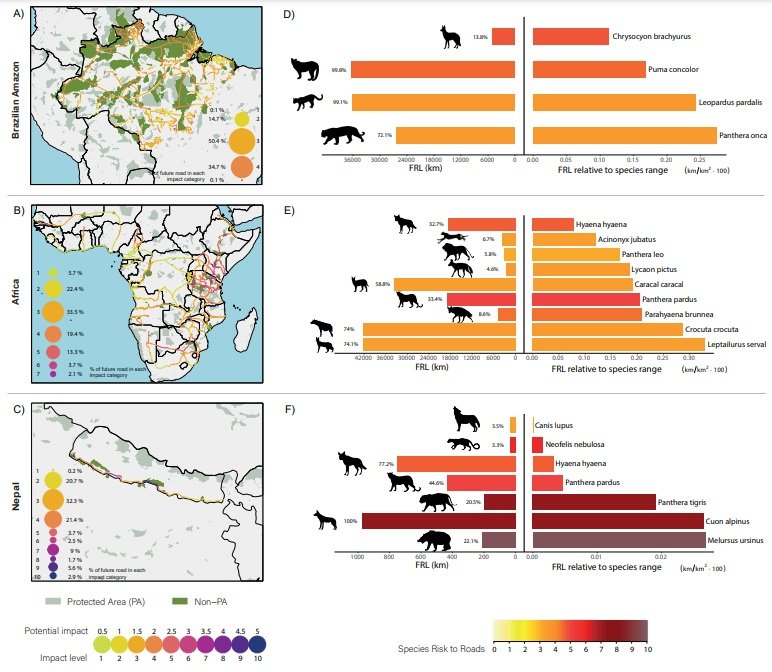Roads are a severe threat to apex predators across the globe
Written by Itxaso Quintana and Edgar Cifuentes
23rd February 2023
Apex predators at risk from roads
Apex predators, such as wolves, lions, sharks and birds of prey, are critically important in maintaining the structure and function of ecosystems around the world. They sit at the top of the food chain and through predation they regulate the number of lower-order species, preventing them from becoming over-abundant.
In our study, we focussed on mammalian apex predators in terrestrial ecosystems. These species are acutely threatened by road development due to their large home ranges, low population densities, low reproductive rates, and intolerance to increased human disturbances. Threats they suffer include mortality from vehicle-strike (roadkills), habitat loss and fragmentation, reduced genetic connectivity, and increased hunting and poaching.
Roadkill is the most direct impact of roads on apex predators. We created a global vehicle-collision database for 36 apex predator species and found that road accidents in the USA impact more than 400 individuals of American black bear per year. In Brazil, more than 300 maned wolves and more than 100 pumas and ocelots are killed in a year. More than 200 serval and Iberian lynx are impacted in South Africa and Spain per year, respectively. Collisions were most common in areas with a combination of high apex predator richness and high road density. More collisions are recorded where there is more monitoring effort, so many areas that have low collision rates may simply lack data.
Figure 1. Sloth bear in India. Photo by: Itxaso Quintana.
Asia, a hotspot of most threatened apex predators
We assessed threats posed by roads on 36 apex predator species, based on their exposure to roads and vulnerability of the species. Our analysis highlights that all apex predators are currently exposed to the global road network (Figure 2). Eight of the ten species most at risk from roads occur in Asia. The sloth bear is the most affected apex predator: 97% of the sloth bear distribution is impacted by roads (Figure 3). The tiger, dhole, Asiatic black bear, clouded leopard, the sun bear, the Sunda clouded leopard and leopard are the remaining seven Asiatic species that are most at risk from roads.
Figure 2. The risk to roads of the 36 apex predator species. Gauges indicate the risk value and bars indicate the standardized road density (red column), proportion of the species geographic distribution that is not formally protected (brown column), standardized number of threats identified by IUCN (blue column), and standardized average body mass of the predator species (orange column) (very large (>100 kg), large (25–100 kg), medium (15–25 kg), small (8–15 kg)). Source of predator silhouettes PhyloPic (http://phylopic.org/) and Gabriela Palomo-Muñoz.
In the Americas, two of the species with higher risk occur in South America: the spectacled bear distributed in the northern Andean Mountain chain, and the maned wolf that occupies open habitats. In Europe, the Iberian lynx suffers from high risk due to its restricted distribution to the Iberian Peninsula, where road density is very high. Among the species restricted to Africa, the brown hyena endemic to Southern Africa, is the predator most at risk.
Figure 3. Map of the distribution of the sloth bear and road density. The only areas without roads are shown in blue – 97% of its range has roads nearby.
Future road development in the Brazilian Amazon, Africa and Nepal
We developed a widely applicable method to assess the potential impacts of future roads and locate highly-impacted road segments. We used it in three case studies which ranged in size from specific countries (Nepal), to regions (Brazilian Amazon) and continents (Africa) where road developments are proposed (Figure 4).
In the Brazilian Amazon, more than one-third of the proposed roads will dissect 175 protected areas, including indigenous lands and sustainable use reserves. The jaguar, ocelot and puma will be the most affected apex predators, due to their affinity for closed-canopy forests. In Africa, the proposed development corridors will fragment the distribution of nine apex predators, and bisect 317 protected areas, including the Serengeti National Park in Tanzania. Finally, in Nepal, completing the Postal Highway in the Terai lowlands will cross the distribution of seven apex predators including the sloth bear and tiger. The road will also transect the Chitwan National Park which is a UNESCO Heritage site and will affect three more national parks.
Figure 4. Potential impact of future proposed road developments in (A,D) the Brazilian Amazon, (B,E) Africa, and (C,F) Nepal. Bubble sizes indicate the percentage of road length under each level of impact. Green areas denote protected areas, and in darker green are the areas that will be intersected directly or within a 10-km buffer around proposed roads. Bars on the left indicate the length (km) of future roads that will cross the species range; the percentage in relation to the complete length of the future development is also shown. Bars on the right indicate the proportion of future road crossing the species range in relation to the species total distribution. FRL = Future Road Length.
Looking into the future
To reduce the environmental impact of road developments, we advocate the need for rigorous road development planning where committees include conservation scientists and wildlife protection organisations, in addition to other stakeholders. Existing wilderness areas should be road-free, proposed roads should avoid protected areas and biodiversity rich areas of co-occurring apex predators. Where roads are truly unavoidable, they must also include the installation of effective mitigation measures, such as over- and under-passes.
Author information
Itxaso Quintana - Biodiversity and Development Institute, Unit 4, Gunner’s Park, Epping 1, Cape Town, 7460, South Africa, Département de Biologie des Organismes et des Populations, Université de Poitiers, Poitiers, France
Email: itxasoqg@hotmail.com
Edgar Cifuentes - Department of Plant Sciences, University of Cambridge Conservation Research Institute, The David Attenborough Building, Pembroke Street, Cambridge, CB2 3QZ, UK
Email: efc35@cam.ac.uk
Author Bio
Itxaso Quintana holds an International Masters Degree in Applied Ecology (IMAE) under the Erasmus Mundus Master Course (EMMC) scheme. She is now a Research Associate at the Biodiversity and Development Institute in Cape Town, South Africa. Her interests encompass understanding the anthropogenic impacts on wildlife to achieve a sustainable world by conserving and managing biodiversity effectively and globally.
Source citation
Quintana, I., Cifuentes, E.F., Dunnink, J.A., Ariza, M., Martínez-Medina. D., Fantacini, F.M., Shrestha, B.R. & Richard F.J. 2022. Severe conservation risks of roads on apex predators. Sci Rep 12, 2902. https://doi.org/10.1038/s41598-022-05294-9
Editor:
Michelle Gadd
Cite this summary:
Qunitana, I. (2023). Roads are a severe threat to persistence of apex predators across the globe. Edited by Gadd, M. TransportEcology.info, Accessed at: https://transportecology.info/research/road-impacts-apex-predators





